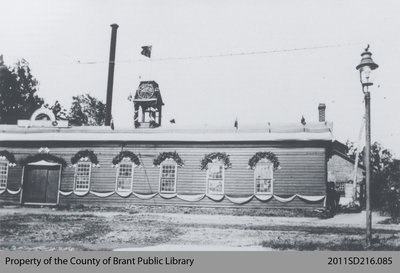
History of the St. George Wagon Works
Through the Hard Time to Public Enterprise
Pages
Robert Snowball's Wagon ShopThrough the Hard Time to Public EnterpriseBusiness ExpandedThe End of the Wagon IndustryOne of the most common occurrences of the nineteenth century was the high incidence of fires. Unfortunately, Snowball’s wagon works did not escape this danger. The stable on the corner of the property used for storing wagon gearings, hubs, etc., caught fire around 6 o’clock on Monday evening of January 19, 1860. The barn and its contents were destroyed in minutes, along with Dr. Kitchen’s barn on the adjacent lot. No insurance was held on the building or contents. The cause of the fire was unknown.
The company began construction of a new building in December of 1881. It was 30 feet wide by 70 feet long and two stories high. The top storey was used for the paint shop and the lower for a wareroom.
In 1883, rumors started circulating around Southern Ontario wagon manufacturers that there was no further need of wagons in the traditional markets of Northwestern Canada and Manitoba. William closed the business for three weeks while he travelled across Ontario in September of 1883. He solicited all known sources and returned with a handful of orders.
For three years the company produced as many units as the market could bear as well as a convenient stock. By the end of 1888, the Snowball Wagon Works had concluded a deal with the Patterson Bros. Wagon Works of Woodstock, Ontario, for all of their output. Patterson Bros., had been burned out earlier in the year and their Northwest trade was suffering greatly. Two train-car loads of wagons were shipped by the end of January of 1889.
On August 7, 1891, William decided to extend his company’s assets. He proposed that a joint stock company should be established. Steps were immediately taken to carry out the plan. Books were opened up to represent the new firm to be named the Snowball Wagon Works Company with a capital of thirty-thousand dollars at $100 a share. The shares were taken up quickly and a decision was made to run the business to capacity. Wm. Snowball acted as the president with some local people as directors. Daniel Jackson of Rockton was hired as the manager of the business.
By early winter of 1891, it had become apparent that the firm was in great financial difficulty. William declared bankruptcy late in November. The Wagon Works sat idle for almost five months until Messrs J. P. Lawrason and Thomas White purchased the stock and rented the factory from the creditors. They immediately rehired a suitable workforce and resumed production of wagons using Dan Jackson’s knowledge as a wagon-maker. The citizens of St. George were glad to hear the sound of the triangle again on weekday mornings.
From the middle 1890s until the turn of the century, production of wagons remained stable. In the first month of 1900, Peter Wood of Brantford (formerly of Beverly) assumed ownership through an outstanding mortgage. He kept the factory operating for two years until December of 1902, when he sold it to the Hamburg American Wagon Company of New Hamburg, Ontario. This company carried on production of wagons for about four months but shut down for lack of orders. They removed all of the lumber and part of the machinery to their New Hamburg factory in May of 1903, leaving the Snowball shops abandoned.
Many of the employees from St. George left for New Hamburg where jobs were available. One of these employees was Wilbur Jackson, son of Dan Jackson.
St. George was stunned by the exodus of so many skilled tradespeople and the uprooting of their families. Townsfolk formed a delegation in an attempt to secure some enterprising soul to take over the manufactory, but to no avail.
A year passed by before things changed. Dan Jackson managed to gather enough money to purchase the idle wagon works company. In 1904 he purchased the business. By March of 1904, Dan Jackson had firmly taken possession and had his company registered as the Jackson Wagon Company Ltd. The new firm was governed by the following officers: S.G. Kitchen, president; Dan Jackson, general manager; Harry Freeman, secretary; J.P. Lawrason (private banker) and Wilbur Jackson, directors.


